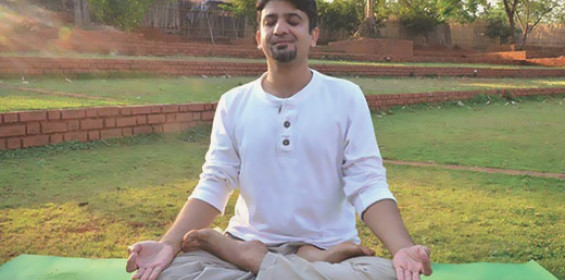I was 20 when I experienced an Advanced Meditation Program (AMP, also called the silence program) for the first time. It had been three years since I had learned Sudarshan Kriya and it had been quite a while since I wanted to experience an AMP. I had heard about a lot of great experiences from my friends. Someone felt super light after a stressful period of time. Someone was able to make the right life decision that they were holding for so long.
Yet, I was apprehensive. How would I stay silent for so long? I wasn’t even sure if I’d be able to sit through the long meditations. But not only were the meditations smooth for me, but I also enjoyed the silence thoroughly. Since then, I have experienced several advanced meditation programs, each of which has helped me in some way or another.
Following are some common challenges people face while doing an Advanced Meditation Program and ways of overcoming them.
Staying silent
This is a fear that most people have. The first few processes in the program do prepare you to go into silence. On the first day of silence, you may experience a lot of restlessness and a bombardment of thoughts. See that as a release of impressions. With time, the intensity of these thoughts will fade away. Balls of muddled thoughts will unroll and give way to clarity, peace, and bliss.
Pro Tip: Start your Advanced Meditation Program journey with short silence programs (3 days program) and then gradually start going for longer ones. For beginners, getting into silence may seem hard. But the only solution is to be patient and go through it because it will pay off well.
Long meditations
If you are scared about sitting for long periods, here is good news for you.
The truth about meditations in an Advanced Meditation Program is that they don’t seem so long. If the meditation is for 20 minutes, it may seem even shorter because that is the impact of deep meditation. And your silence makes it easier for you to go deep. Also, the program doesn’t just consist of meditations. You will enjoy well-timed breaks, seva (physical activity), and nature walks as well.
Pro Tip: Carry cushions and a meditation chair with yourself to make your body feel comfortable during meditations.
Quality & deep meditations

In my first Advanced Meditation Program, it felt like I was the first to open my eyes after a meditation session, in a crowd of hundreds. I noticed people in deep meditation, sitting with their eyes closed, long after the instruction was over, and who seemed to be enjoying a secret revealed only to them. I wondered why my meditations weren’t that deep. Over the years, I realized that the more regular you are with yoga, Sudarshan Kriya, and meditation in your daily routine, the deeper you can go into an Advanced Meditation Program.
Pro Tip: Commit yourself to a daily practice of Sudarshan Kriya and meditations for fifteen days before your silence program begins.
No WhatsApp and communication with your dear ones
Before you are initiated into silence, you will be asked to talk to your dear ones and let them know about your silence program. Thus no one will be worried about you while you keep your phone in silence during your silence. This time period is really about being with yourself, and halting your communication for a few days will only help you go deeper and enjoy your meditations better.
Pro Tip: Before going into silence, delegate your work and make it clear that you won’t be available. Talk to your dear ones before and after the program gets over.
Simple food
What you eat affects your mind and body. That’s why simple sattvik food is served during the residential silence program. It helps curb restlessness in the mind, increases awareness, and aids your silence and meditation. Having this kind of food may seem hard for some. Here is a tip for those.
Pro Tip: Eat your sattvik silence meals slowly. Chew a morsel 30 times or more. You will realize the food is not that bad, and in fact, is delicious. You can also motivate yourself in the beginning by promising yourself a meal at your favorite food joint after the program gets over.
Sharing rooms
Most of us are accustomed to enjoying our privacy in our single rooms. The idea of sharing rooms, especially with strangers, is uncomfortable. But most of the time, you will be out of your rooms participating in the program. You will only share your morning routine and sleep time with your equally silent roommates and it will be only for some days.
Pro Tip: Fix your morning time slots with your roommates before you get into silence. This will avoid confusion. Share any other concerns like switching off the lights during bedtime and so on with your roommates. In most cases, people are understanding and don’t want anyone else to feel troubled because of them.
Getting up on time
Most silence programs begin at 6 AM. You will have to reach the venue by this time. If you get up late, you may miss your program, or worse, the teacher may ask you to join the next batch. Discipline is taken seriously.
Pro Tip: Intend to get up on time. Alarms and a bedtime intention will do just fine to help you wake up.
Written by: Vanditaa Kothari
Sign up for an Advanced Meditation Program today.
Advanced Meditation Program is a 3, 5, 7 or 10-Day intensive program with advanced meditation techniques, pranayama, rejuvenating yoga and other ancient techniques to experience deep rest and overcome negative emotions with ancient wisdom and meaningful silence. It is available in online and offline formats in your preferred language.
Anyone who is 18 or above and has learned the Sudarshan Kriya breathing technique in an entry-level program of The Art of Living can join in.
There will be sessions in the Advanced Meditation Program where you will be required to practice the Sudarshan Kriya.
Sudarshan Kriya is a rhythmic breathing technique taught in the Online Breath and Meditation Workshop. You can also choose to learn it in an offline Happiness program.
You must be over 18 years of age
You must have done the Online Meditation & Breath Workshop / Happiness Program / Youth Empowerment Seminar (YES!+) / Student Excellence and Learning Program (SELP)
Free up your schedule for three days to allow yourself to focus on the program
Advanced Meditation Program is a 3-Day intensive program with Advanced Techniques to experience deep rest.
The Art of Living Silence Program or Advance Meditation Program has 'silence' as an integral part. Silence is the mother of creativity. This program leads you to a state where your latent skills and talents manifest. You can go beyond the usually active mind and experience an extraordinary sense of calmness through meaningful silence observed during the program.
















































